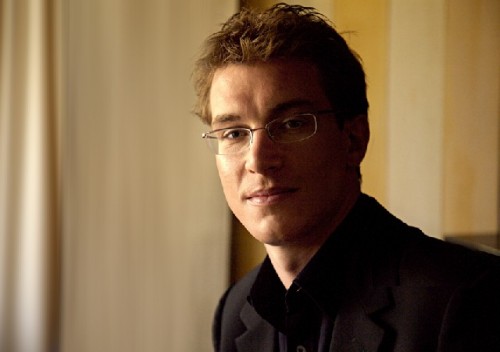Gilles Vonsattel Delivers at Tanglewood
Substitute Soars with Brahms' Piano Concerto No. 1.
By: Adrian Hill - Jul 26, 2010
.Imagine being the understudy for Hamlet on Broadway. Or maybe Don Giovanni at the Met. You know all the lines. You can play the part perfectly. But no one ever sees you on stage. You live anonymously in the shadow of someone else’s star. Suddenly, the star calls in sick. With barely a moments notice, you must step out on stage and perform under pressure the piece you know so well. Only this time, you’re not performing for an empty theater during a rehearsal. Every seat in the theater is filled with people wondering if you can rise to occasion and deliver like Mariano Rivera in the bottom of the ninth inning. That was the role Gilles Vonsattel suddenly found himself in Saturday night with the Boston Symphony Orchestra on stage at Tanglewood. When world-renowned pianist Peter Serkin was forced to cancel last week due to illness, Vonsattel was called upon to play the piano solo in Brahms’ Concerto Number One. The young Swiss-American virtuoso rose to the challenge and delivered an enthusiastic performance of this challenging piano music during his debut performance with the BSO at Tanglewood. And by the end, he was rewarded for his efforts with a standing ovation from the crowd seated before him in the Shed. Actually, casting Vonsattel as the unknown understudy is not quite fair. He’s performed in concert halls across the world, been praised by critics and received several prestigious awards, including a 2008 Avery Fisher Career Grant and the top prize at the 2002 Naumburg International Piano Competition. And starting this fall, he’ll serve as an Assistant Professor of Piano at the University of Massachusetts at Amherst. Perhaps his professorship at the nearby university landed him the last-minute assignment Saturday at Tanglewood. Whatever the reason, Vonsattel settled into his role just fine that night. Brahms’ first concerto is a good fit for a young pianist like Vonsattel. The composer wrote the popular piece when he was in his early 20s. But the music - and Vonsattel’s performance - is anything but immature. Brahms began writing the music for the concerto in 1854, the same year he reportedly fell in love Clara Schumann, the concert pianist and wife of his friend, composer Robert Schumann. I’ve never been a fan of reading too much into someone’s life to decipher what their art “means,” whatever that means. But it’s hard not to imagine that Brahms channeled his passionate longing and ultimately unrequited love (Clara and Brahms never married) into his music. Brahms’ Concerto Number One sounds like something Beethoven might have written if he were listening to a lot of Chopin. Then again, Brahms revered Beethoven. (He kept a marble bust of the late composer in his house.) And even though Brahms was not reportedly a close associate of Chopin, you can clearly hear hints of that composer’s enigmatic piano sonatas in the quieter sections of the Brahms’ Concerto Number One. What makes Brahms’ first concerto so satisfying is the juxtaposition between the bombastic, pulsating music for orchestra and the often light-as-air piano solos, especially when the pianist enters for the first time in the first movement. Vonsattel set the tone perfectly right from the start. And he kept right up with the rest of the orchestra as the music raced ahead and slowed down from one movement to the next. Vonsattel’s playing became a little too aggressive in later parts of the concerto. And he moved his upper body around too much at times as he performed some of the more animated sections of Concerto Number One. But cut the guy some slack. Here he was, performing on stage before thousands of people on a Saturday night for the first time with one of the world’s greatest orchestras. I’d be pretty excited too! When the crowd rose to applaud Vonsattel’s performance, I kept thinking, I hope his family is in the audience to see this reaction. Then again, judging from his performance Saturday, I’m sure they will have plenty of other opportunities to see Vonsattel at Tanglewood for years to come. The second half of the all-Brahms program Saturday night featured his Second Symphony. Brahms composed this symphony 18 years after the first concerto. The second symphony debuted in 1877 in Vienna. Brahms wrote the symphony that summer while living in Pörtschach am Wörthersee, a popular, rural tourist destination in Austria during the 19th Century. According to Brahms, he wrote that the Second Symphony “is so melancholy that you won’t be able to stand it. I’ve never written anything so sad.” Maybe Brahms was joking. Maybe it was the idyllic, serene setting at Tanglewood. But the symphony sure didn’t sound like something Morrissey might have written for The Smiths after spending another rainy day alone in his room. Brahms was no solemn shoe gazer. Then again, the second movement of Brahms’ Second does have a tinge of longing and yearning to its softer sections. But overall, the symphony has an approachable, easy going rhythm that puts the listener right at ease. Brahms may have wanted people to secretly see the symphony as having hidden shades of darkness. But that sounds about as believable as Tom Cruise trying to play a tough-talking bad guy in a film noir. We just don’t buy it. He’s too much of a Boy Scout.
Until now.
I agree with the comparisons between this symphony and Beethoven’s Sixth “Pastoral” Symphony. And I can’t imagine a better setting to savor such sumptuous, serene music.


